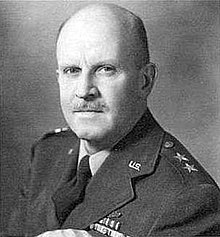Gordon Philip Saville | |
|---|---|
 Major General Gordon Philip Saville | |
| Born | September 14, 1902 Macon, Georgia, US |
| Died | January 31, 1984 (aged 81) Lackland Air Force Base, Bexar County, Texas, US |
| Allegiance | |
| Service/ | |
| Years of service | 1923–1951 |
| Rank | |
| Commands | XII Fighter Command First Tactical Air Force III Tactical Air Command Air Defense Command |
| Battles/wars | World War II |
| Awards | Distinguished Flying Cross Distinguished Service Medal (2) Bronze Star Medal Legion of Merit Air Medal |
Gordon Philip Saville (September 14, 1902 – January 31, 1984)[1] was a United States Air Force major general who was the top authority on US air defense from 1940 to 1951. Blunt and direct in manner, Saville had been an outspoken proponent of tactical aviation in the 1930s against a brotherhood of airmen who promoted strategic bombing.
Saville succeeded Claire L. Chennault as America's leading fighter aircraft tactician. With Benjamin S. Kelsey, Saville co-wrote the technical specifications which led to the Lockheed P-38 Lightning and the Bell P-39 Airacobra fighters. In 1949 he selected the North American F-86 Sabre as America's main defense fighter, and in 1950 he approved a guided air-to-air missile system that would be carried aboard the proposed supersonic 1954 interceptor; the missile produced was the AIM-4 Falcon.
Saville was a technical and scientific-minded leader who helped pioneer advanced mathematics for operations research, and computer systems for centralized coordination of air defense. He advocated the expansion of radar installations to create an unbroken air defense network. He explored the concept of a military aircraft designed around an integrated electronics fire-control system built by various subcontractors.[2] After retiring from the military, Saville worked in the defense industry.
- ^ "USAF Biography: Major General Gordon P. Saville". Archived from the original on 2009-09-06.. Retrieved on November 19, 2009.
- ^ Jacobs, Donald (May 9, 1990) [February 28, 1989]. Martin Collins (ed.). "The Glennan-Webb-Seamans Project for Research in Space History: J–R". Space History Division, National Air & Space Museum, Smithsonian Institution. Oral history interview of Donald Jacobs by Martin Collins. Summary of tape contents.